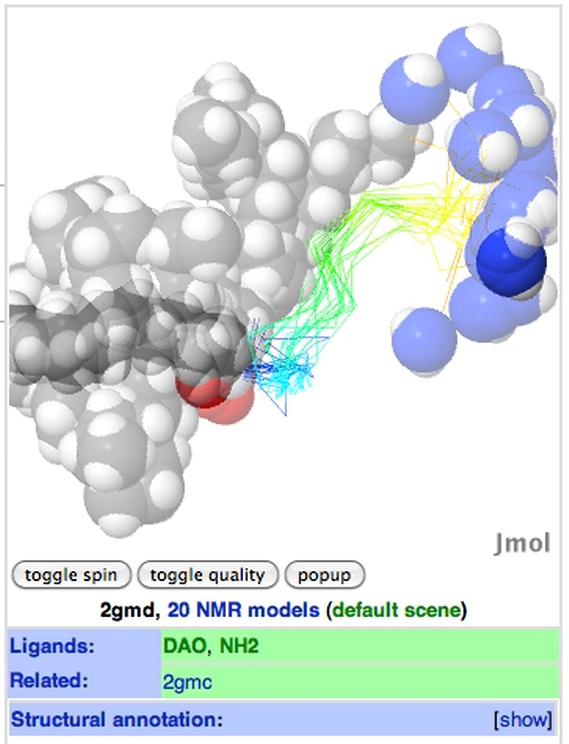
for Structural Bioinformatics Protein Data Bank
Number 48
| EDUCATION
CORNER Proteopedia: An online, collaborative 3D-encyclopedia of proteins & other molecules by Jaime Prilusky, Ph.D., Weizmann Institute of Science As a wise man said, "A picture is worth a thousand words," and it happens to be true most of the time. Try to imagine this scene: "The amino acid residues near the heme group in hemoglobin shift as the heme group converts between the non planar and the planar conformation by binding and releasing a molecule of O2." A description like this might elicit the proper mental image from an experienced crystallographer, and a somehow correct image from a biologist. You don't want to know what university or high-school students can make of it. It's well known that the relationships between protein structures and functions are difficult to grasp, even for crystallographers. Masterpiece works like Goodsell's Molecule of the Month pages, with crisp and attractive drawings of molecules and easy-to-follow, accurate textual descriptions, greatly aid the understanding of the 'what,' 'why,' and 'when' around structures. Still, the connection between the words and the flat drawings are left as a mental exercise for the reader. And anything can happen when imagination flies. Proteopedia came to the rescue with a simple concept: a web page (any platform, any browser) with a descriptive text, a '3D' structure that the user can rotate and change at will, and green 'hot' words between the text that interact with the 3D structure when clicked. Before Proteopedia, the sequence of events while reading about structure and functions was something like this: first, read the description; then, imagine how this translates onto the static image. With Proteopedia, the sequence of events is: click on the green words while reading the text description; then, observe the structure coming alive, rotating and changing its form to demonstrate what the text suggests. A whole new and rich experience of discovery for students and for teachers! It's not surprising that education is one of the fields where Proteopedia's scenes have more impact. Teaching how data in a PDB file from a NMR experiment differs from that of an X-ray experiment might be possible, but it's easier if the student is able to compare, play, and manipulate representations of the 3D model of NMR and X-ray structures. This figure shows successive snapshots of a rotating representation of the PDB entry 2gmd, from an antimicrobial protein solved by NMR. The balanced use of solid and semi-transparent colors enhances the browsing of NMR structures. Proteopedia was created in 2007 at the Weizmann Institute of Science, Israel, by Joel Sussman, Eran Hodis, and Jaime Prilusky, with brainstorming and suggestions from Israel Silman, John Moult, and Eric Martz.1 Since its creation, the number of users has grown steadily, as has the number of pages contributed by users and the range of fields where Proteopedia is being used. Who's using Proteopedia.org?
There are also Proteopedia pages on basic knowledge that help in understanding the data handled and maintained in the PDB, like Atomic Coordinate File, Resolution, PDB Identification Code, and Protein Data Bank. Proteopedia couldn't exist without the structure files watched over by the wwPDB. The coordinates in the structure files provide the base for the 3D representation, and Proteopedia keeps a weekly updated selection of pages, including every one of the more than 70,000 PDB structures. Creating Proteopedia pages with colorful live scenes is easy. The site contains text and video tutorials, and even 'crash course' instructions for the impatient. During our hands-on workshops, people start creating live 3D scenes in the first 30 minutes. When creating pages on Proteopedia, you may choose between different degrees of protection, depending on the namespace where the page is located, as described on the table. Workbench pages offer the ideal shared protected environment for collaboration. They are protected for read/write access, and the page creators may grant, to any Proteopedia user, read access to owned Workbench pages via provided tools.
Finally, if you're searching for a topic to motivate your students or to discuss at your next talk, take a look at Proteopedia's Believe It or Not!, a page containing a list of useful, useless, or simply interesting facts about proteins, structures and what's around them. This page is automatically updated by OCA, the browser and database for structure and function. Give Proteopedia.org a chance to help you, your partners, and students to better explain and understand the relationship between structure and function. 1. E. Hodis, J. Prilusky, E. Martz, I. Silman, J. Moult, J.L. Sussman (2008) Proteopedia - a scientific 'wiki' bridging the rift between three-dimensional structure and function of biomacromolecules. Genome Biol. 9: R121. doi:10.1186/gb-2008-9-8-r121 |
E-mail: info@rcsb.org • Web: www.pdb.org • FTP: ftp.wwpdb.org
The RCSB PDB is a member of the wwPDB (www.wwpdb.org)



